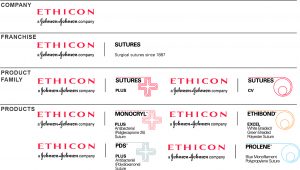Sooner or later (sooner is much better), companies face the vital need to manage their Brand Architecture: the relative relationship between corporate, franchise and product/service brands. Brand Architecture could be a long story in and of itself (it occupies a chapter in my book, Identity Crisis). Suffice it to say for this blog that Brand Architecture is both an exercise in vertical hierarchy (master brand and sub-brands), as well as horizontal brand family relationships. Whichever architecture a company chooses, the strategies and imperatives it creates are of paramount importance to understand. Here are five principles to keep in mind to insure success in a Brand Architecture initiative:
- Companies must have the institutional will. Architecture doesn’t just reside on paper; it follows with budgetary and staffing imperatives. The most common request I get is to create a Franchise level in the architecture—a master category (e.g. Oncology) or master brand (e.g. Ethicon Sutures) that govern sub-brands like other drugs or indications. To sustain a franchise, brand architecture reorients the company’s priorities. The company must have a staff and budget sizeable enough that the individual brand managers within the Franchise are incentivized to compete for the franchise’s subsidies and cooperation. Without such resources in place at the franchise level, the individual brands will do whatever they please because the company doesn’t have any mechanism for compelling compliance.
 Trying to “tax” the individual brands so that programs can be fielded at the Franchise (portfolio) level will not only fail to generate results, it will also frustrate and anger the brand managers who will contend that they are receiving mixed messages about how their performance will be measured: product sales or company cooperation? These two incentives can often be at odds, especially for flagship sub-brands that deliver hefty profits for the franchise and seek all the money they can “keep” from other, less successful brands in the franchise.
Trying to “tax” the individual brands so that programs can be fielded at the Franchise (portfolio) level will not only fail to generate results, it will also frustrate and anger the brand managers who will contend that they are receiving mixed messages about how their performance will be measured: product sales or company cooperation? These two incentives can often be at odds, especially for flagship sub-brands that deliver hefty profits for the franchise and seek all the money they can “keep” from other, less successful brands in the franchise. - Be smart enough to field branding research. This may sound like a no-brainer, but many companies do not bother to do external research with customers about their plans for a Brand Architecture. Further, whatever research they do field too often is about the product brands themselves and not how the brand identities of the company and the individual products reflect customer esteem. Research that focuses on traditional marketing measurements—awareness, share of voice, ranking of product elements—may be helpful in building campaigns and messages, but they hardly scratch the surface of why grouping these brands into a franchise would be welcomed by customers. Discover if customers identify with your company values, and which ones they esteem the most. Understand the equity of your product brands in customers’ minds. Do they leverage any corporate values? Do they share a common value? If combined, is the sum greater than the collective parts? By conducting brand identity research, you can learn the value of each perceptual asset in the portfolio and use these as building blocks for your franchise.
- Dare to stand for more than just the products you sell. Back in the 1980s, a relatively small company named Stuart Pharmaceuticals made a commitment to meet a market need in oncology. While chemotoxic brands (those that kill cancer) and chemostatic brands (those that keep cancer from growing), were the main subject of research and development for other companies, Stuart was among the first to realize the potential of hormonal therapies in breast and prostate cancer. (These are called adjuvant therapies, or therapies used to sustain a cure from other agents.) Their first drug brand, Nolvadex (tamoxifen), would go on to become one of the best selling and paradigm-changing brands in the category. However, before its launch, no oncologist had ever heard of Stuart Pharmaceuticals. So their oncology franchise did something that the oncology community sorely needed: it committed to raise awareness about breast cancer, its devastating effect on the population, and the need for early screening.
 Working with their agencies, at one of which I was a key leader on the healthcare promotion side of the equation, they created and promoted Breast Cancer Awareness Day in conjunction with leading doctor and patient societies. Not only did the oncology community become immediately cognizant of Stuart, but they also applauded the fact that the company was investing in more than just promotion for their upcoming drug. Of course, today we all appreciate the phenomenon that has become Breast Cancer Awareness Month. The Stuart oncology franchise went on to launch their portfolio of brands, each with the franchise family suffix: Zoladex, Arimdex, Casodex, and Faslodex. Today, we know Stuart by a new company name, Astra-Zeneca, one of the world’s leading pharmaceutical brands. And they can trace their franchise success to their sage wisdom of daring to stand for more than just the products they sell. They committed to a cause that rallied a nation and at the same time gave their brand the national visibility it needed for long-term success.
Working with their agencies, at one of which I was a key leader on the healthcare promotion side of the equation, they created and promoted Breast Cancer Awareness Day in conjunction with leading doctor and patient societies. Not only did the oncology community become immediately cognizant of Stuart, but they also applauded the fact that the company was investing in more than just promotion for their upcoming drug. Of course, today we all appreciate the phenomenon that has become Breast Cancer Awareness Month. The Stuart oncology franchise went on to launch their portfolio of brands, each with the franchise family suffix: Zoladex, Arimdex, Casodex, and Faslodex. Today, we know Stuart by a new company name, Astra-Zeneca, one of the world’s leading pharmaceutical brands. And they can trace their franchise success to their sage wisdom of daring to stand for more than just the products they sell. They committed to a cause that rallied a nation and at the same time gave their brand the national visibility it needed for long-term success. - Build the brand family around your customers, not your brands. I started off this discussion by addressing the need to base the franchise (portfolio) identity around customers and their lives. If I had to name the single greatest error most companies commit in fielding a franchise, it would be failing to abide by this principle. Sure, companies create franchises for good internal reasons: better resource allocation across the portfolio, a better way to position the assets in the portfolio to maximize profits as a whole, a great way to energize and incentivize marketing and sales personnel. However, when it comes to creating an external promise to customers, the franchises that continue to look only inward will ultimately fail. Ethicon, discussed earlier in this blog, learned this lesson well. The quality and reputation of Ethicon’s many brands are an acknowledged aspect of the company’s equity among customers. But healthcare cost containment is perhaps the single greatest ongoing issue facing hospitals.
 So despite the high esteem hospitals and surgeons have for the Ethicon brand, circumstances compel them to purchase cheaper brands from opportunistic competitors. Sales began to decline for each element in the Ethicon portfolio: sutures, needles, scalpels, and structural mesh used to strengthen tissue in certain procedures and so on. Hospitals began awarding contracts for each item to the lowest bidder. But Ethicon knew their customers, and used the principles we have discussed above to right the ship. They discovered that hospitals needed something more than just supplies; they needed to simplify supply management and streamline procedures. If hospitals could do this, they would save much more money than by pinching pennies on the supplies themselves. Ethicon reorganized the company franchise offerings not by the products, but rather by the procedures that surgeons performed: The Hernia Franchise, The Breast Augmentation Franchise, The Bariatric Surgery Franchise. By bundling products and services tailored toward how their customers used them in concert with each other, Ethicon regained its dominance through a customer-centric Brand Architecture approach.
So despite the high esteem hospitals and surgeons have for the Ethicon brand, circumstances compel them to purchase cheaper brands from opportunistic competitors. Sales began to decline for each element in the Ethicon portfolio: sutures, needles, scalpels, and structural mesh used to strengthen tissue in certain procedures and so on. Hospitals began awarding contracts for each item to the lowest bidder. But Ethicon knew their customers, and used the principles we have discussed above to right the ship. They discovered that hospitals needed something more than just supplies; they needed to simplify supply management and streamline procedures. If hospitals could do this, they would save much more money than by pinching pennies on the supplies themselves. Ethicon reorganized the company franchise offerings not by the products, but rather by the procedures that surgeons performed: The Hernia Franchise, The Breast Augmentation Franchise, The Bariatric Surgery Franchise. By bundling products and services tailored toward how their customers used them in concert with each other, Ethicon regained its dominance through a customer-centric Brand Architecture approach. - Recognize that it is a marathon. If ignoring principle number four is the most common error in Franchise development, then my last principle here is decidedly the second most common. Don’t start a Franchise architecture if your company cannot or will not sustain the effort for a long time. Too many companies have ruined their reputations by forming a Franchise while they have brands to support it, only to fold the tent once the brands lose their patents. Customers will never forget such a betrayal. And the next time that the company tries to restart the Franchise approach, customers will mistrust their intentions, and avoid engaging with them or their brands. This behavior can be found in companies of all sizes. Large companies that focus on different revenue streams from different therapeutic categories can be distracted from one commitment as they try to foster too many others. Small companies may never amass the muscular resources needed to truly fulfill the promise that is in their hearts. They can all grow fatigued and drop out of the race by not recognizing that their customers are running a marathon, while they were in a sprint.
Of course, Brand Architecture is always necessary even if you are not forming a franchise. How much do you leverage your corporate brand? How do the product brands each fend for themselves without cannibalizing each other. How do the product brands leverage the success of their sibling brands? A sound Brand Architecture model will help you and your customers to get on the same page.
